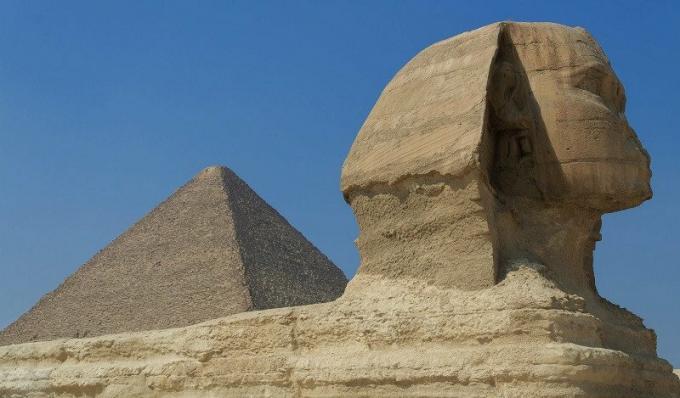The Sphinx of Giza: origins and characteristics of this Egyptian monument
It is not the only sphinx that the Egyptian civilization has left us, but it is the most spectacular. The Sphinx of Giza stands majestically 450 meters from the Great Pyramid; His eyes are directed to the east, aligned with astonishing precision to the east-west axis of the temple in front of her, which, during the equinoxes, point to the setting sun.
From the ground to the tip of its head it measures 20 meters, and from its front legs to the beginning of its tail (which it keeps folded to one side) it is 70.5 meters long. A colossal titan that seems to keep the eternal sleep of the pyramids that rise next to it.
But despite its indisputable beauty, the Sphinx of Giza still raises many questions. When was it built, and by whom? Whose is the mysterious face covered by the nemes real? Why was his body kept buried in the desert sands, since ancient times? What does it mean? Join us to discover the secrets of this enigmatic Egyptian construction.
- Related article: "25 Egyptian Gods (Biography, Personality, and Legacy)"
The Sphinx of Giza: a monument older than Egypt?
Traditionally, scholars have dated the construction of the Sphinx of Giza to the Fourth Dynasty, around 2,500 BC. c. However, other investigations point to very different results, since they consider the possibility that the sphinx was built no less than 10,500 years ago.
If this were true, we would be faced with two possibilities: either the Egyptian civilization is much older than is believed, or the sphinx is the product of an earlier civilization. In fact, during the 20th century, pseudoscientific theories began to proliferate that claimed that it had been raised by none other than the Atlanteans, the mythical lost civilization of which the texts speak ancient.
The belief, which has no scientific basis, made a deep impression on some "experts"; Among them, Edgar Cayce (1877-1945), an American supposed visionary and medium who defended the Atlantean theory back in the 1930s. In his last years, Cayce assured that before the end of the millennium the room with the "secret archives" of the Atlanteans would finally be found, just below the Sphinx of Giza. And, oddly enough, some explorers and adventurers believed in his theory. Rondha James (Marjorie Hansen's pseudonym) and her sister set out on an enthusiastic journey to Giza to find that secret file once and for all. As expected, they found nothing.
- You may be interested in: "Archaeology: what is it and what does this discipline study"
Erosion remains on the Egyptian Sphinx
However, there was some reality in all these theories. And it is that there was evidence that the body of the sphinx had been eroded by water, which connected with the hypothesis that it had been built before the year 10,000 a. c. It is known that, just at that time, Egypt suffered a series of floods, which is one of the very few explanations for such erosion, since in Egypt it hardly rains. This is at least the theory supported by the German Egyptologist Schwaller de Lubicz (1887-1961), who was excavating in the area between 1937 and 1952.
But the hypothesis of the remote antiquity of the sphinx has been questioned by numerous specialists. In fact, the erosion of the sphinx could be caused simply by rain, since, at Despite the fact that in Egypt rainfall is scarce, it does occur sporadically torrential.

The sphinx does not only show signs of erosion by water. The limestone used for its construction has different qualities depending on the level; For example, the rock of the sphinx's body is weaker than the head, made of a much harder and more resistant stone. However, both one and the other show obvious signs of deterioration due to the winds and the constant rubbing of the desert sand, which indicates that, despite having remained half-buried for millennia (already in the time of Herodotus, the Greek traveler, only his head protruded from the sand) the porosity of the limestone used did not contribute to its conservation.
Guardian and protector of the Egyptians
Sphinxes are not at all unusual in ancient Egyptian culture.. Throughout the land of the Nile we find many of these creatures, as they had a protective function that was highly valued by the Egyptians. The first known date from the III millennium BC. c. and also corresponds to the IV dynasty. It was found in Abu Rawash, the funerary complex of Pharaoh Djedefre, the successor of Cheops. However, it is in the Middle Kingdom when a greater profusion of sphinxes begins to be found throughout Egypt, always as guardians and protectors, which differentiates them from the sphinxes of Greek culture, considered bearers of evil omens.
Another difference between the Greek and Egyptian sphinxes is that, while the former tend to be upright and have the bust of a woman, the Egyptian sphinxes are lying down and present the body of a lion and the head of a man. Giza's is no exception; indeed, the gigantic leonine forms of her body are much larger, in proportion, than her head, considered by many to be "too small."
The identity of the enigmatic face is a source of discussion among specialists. There are two theories about it; the first, that it could be representing Pharaoh Kefren, a hypothesis that seems to be demonstrated by the proximity of this pharaoh's temple. The second was launched by the German Egyptologist Rainer Stadelman (1933-2019), and argued that the face would be a representation of Cheops, a pharaoh before Khafre.
According to this specialist, the deviation that can be seen on the road that leads to the pyramid of Kefren it would have been a necessary constructive turn to avoid the sphinx, which would already have been built at the time of this Pharaoh. Cheops would have raised the image of him as a guardian lion, a resource widely used in ancient Egypt, where the pharaoh was clothed with the role of guide and protector of his people.
- Related article: "The 8 branches of the Humanities (and what each of them studies)"
And the nose of the sphinx?
Covering the face of the pharaoh we can see the nemes, the royal headdress worn by the rulers of Egypt. It is known that the sphinx was polychrome because traces of blue and yellow paint have been found on it, as well as traces of red pigment on the face and body. About him nemes he rises ureus, the cobra that symbolized the cobra-goddess Wadjet, the protector of Lower Egypt and Pharaoh.
But if something stands out in the face of the sphinx, it is the absence of a nose. On this many rivers of ink have flowed; until not long ago the legend persisted that it was the cannons of Napoleonic troops that blew up the appendage during the Egyptian campaign of 1799 (in which, by the way, the famous Rosetta stone was discovered).
The story of Napoleon and his soldiers blowing up the sphinx's nose is just a myth, but today historians still have doubts about what happened. One of the most accepted theories is the one that places the mutilation in the fourteenth century, during the Arab domination. It seems that the local peasants gave offerings to the sphinx, captivated by its majesty. Muhammad Sa'im al-Dahr, a Sufi traveler, interpreted the act as flagrant idolatry and, full of anger, smashed the nose. At least, this is how it was recorded by the Arab historian Al-Magrizi in the fifteenth century.
The Sphinx of Giza remains a mystery, as much or more than it was to its contemporaries. The ancient Egyptians called it shesep-ankh, “living image”. Later, the Arab settlers knew her as Abu-el-Hol, "Father of Terror". And it is that, be it admiration or respect, the sphinx of Giza never leaves the traveler who wants to get to know it indifferent.


